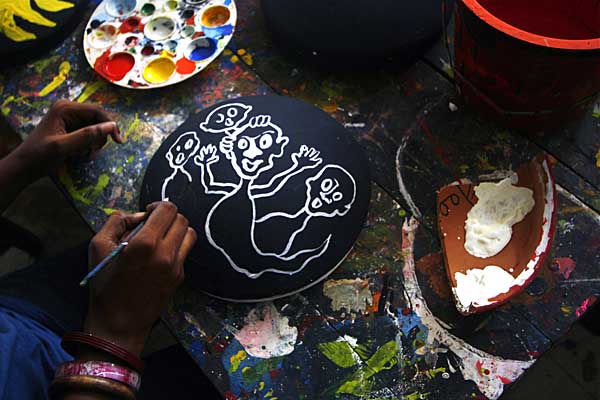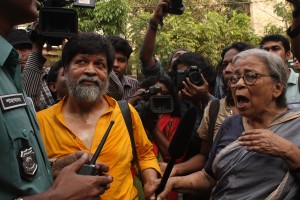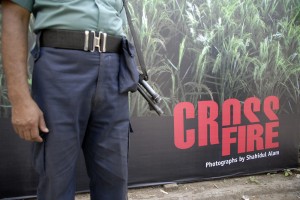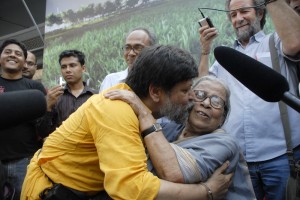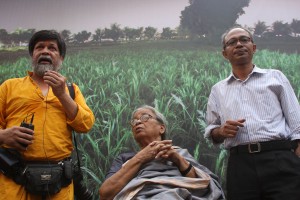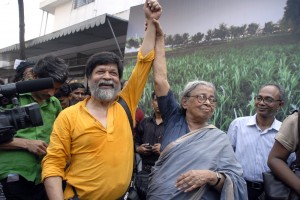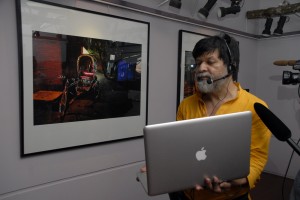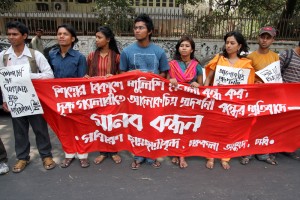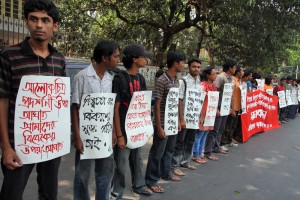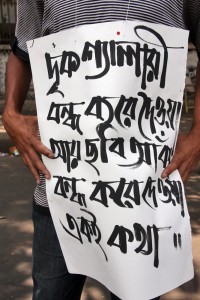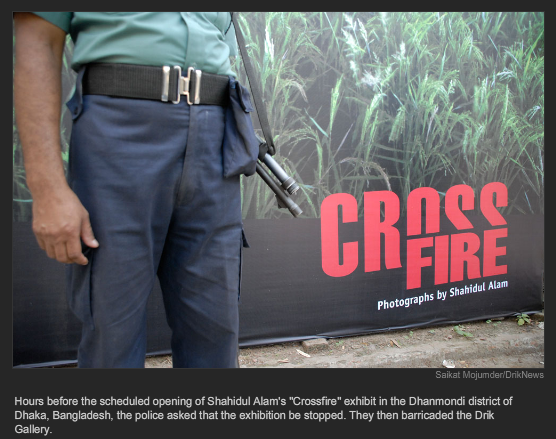The Golam Kasem Lecture Series
By: Dhali Al Mamoon
6th September 2009. Drik Gallery Dhaka
Painting and Photography
Dhali Al Mamoon
Is there an art form that does not draw upon other disciplines? Are literature, music and architecture not informed by visual culture? Are the many manifestations of visual art not encapsulated within them? Today, the boundaries of creative work are difficult to define. If one has to draw a boundary, perhaps it is the sky. The activities that question our intellect, philosophy, science or art ? have all directly or indirectly, become complementary.
Painting and photography, these two forms of visual art are about seeing and showing, creating images and visual signs. The differences in their mode of production, has created some particularities. Painting is not merely the earliest form of visual art, but also the earliest example of human creativity. In this long journey, its structure, its form, its language and its expression both outside and within, have drawn upon each other and gone through transformations. Photography, the youngest of the visual art forms, is less than two centuries old, but has gone through dramatic shifts both within and outside.
The advent of this young visual art form has influenced painting, the earliest visual art form, the most. Very few painters have been able to distance themselves from this influence. According to many, photography has evolved from within the fine arts. Painters have searched for ways to capture the fleeting visuals that surround them, and it is this need that has enabled the discovery of photography.
Earlier in this decade the celebrated British painter David Hockney through his book, ?Secret Knowledge? analysed the creative practices of prominent western artists. This led to a storm of controversy in learned circles, for in that book, Hockney talks of how, well known artists had, prior to photography, used various techniques to enhance their painting skills. Da Vinci, Vel?zquez, Caravaggio, Van Eyke and many other painters had used lenses, mirrors and many other optical devices, to help them create their paintings. The book provides detailed descriptions of these techniques.
One of these devices was the camera obscura. Astronomers had used the camera obscura to obs as early as erve heavenly objects1630. This led physicists and optical scientists to the invention of the telescope and the microscope which revolutionized astronomy and the world of unseen microscopic objects. It opened up a new frontier in our visual culture.
The camera obscura took on many shapes and forms between the 16th and 19th centuries. Large, small, with and without lenses, with reversing mirrors, etc. They were all designed to render a faithful rendering of the scene before us.
Of those who were involved with painting and the visual arts, and also played an important role in the development of photography, a key figure was Louis-Jacques-Mand? Daguerre. Well before he began to improve upon the camera obscura he had established a reputation as a painter, particularly in panoramic painting and theatrical illusion. He later invented the diorama. He began experimenting with photography since 1823. Meanwhile another artist, Joseph Nic?phore Ni?pce successfully created a permanent rendering of a scene in 1822. Ni?pce had been working on lithographs for quite some time. So the advent of photography involved an amalgam of the two disciplines right from the start. Daguerre and Ni?pce began collaborating on their research, and overcame many of the obstacles in their path. In 1833, after the death of Ni?pce, his son succeded him as Daguerre?s partner.
Daguerre?s successful use of photography in 1839 (by a process known as the Daguerreotype) when he was able to record the effect of sunlight through chemical means, created a stir, and the Parisians felt this was superior to painting as it was more lifelike than painting could ever be. The Daguerreotype became increasingly popular and the use and power of photography spread. At the same time, Daguerre was given more responsibility, particularly in the preservation of valuable documents.
By the time photography became ubiquitous in the representation of human activity, the human landscape had also begun to change. Industrialisation led to the disappearance of earlier modes of living. Perhaps the camera too is a product of this industrialization. Photography?s ability for accurate representation led to a rapid increase in its usage. Since the Paris Commune, photography began to be used as material evidence in many political investigations. The revolutionary transformation that had taken place in advertising, post-Napoleon, due to the lithograph, was succeeded by a similar transformation due to photography. The role played by painting was gradually taken over by photography. Gradually, photography took on a more diverse role. Its contribution in extending the scope of visual arts to that of visual culture, is well recognized. On the other hand its replicability gave the image a popularity which other visual art forms like painting lacked due to the limitations of the medium. Rather, even in the fine art spectrum, the reproduction of paintings through photography has led to its democratization and a place in popular culture. Other artwork in museums, galleries and private collections, have become more accessible to the general public by their reproduction through photographs. Consequently, the chapters in western contemporary arts that have gained in prominence, owe their success to the discovery of photography. The advent of photography has transformed the structure of painting, its language, its technique and its perception. In adapting an image or painting to the confines of the photographic process there are elements that get truncated. Before the advent of the mechanical eye of the camera painters were very conscious of these truncations and ensured that the canvas was able to contain the gaze of the viewer. Visual boundaries were created through the use of shadows, or play of colour to restrain the eye. However, dividing the canvas itself was deemed acceptable. The image is a fragment of the visual scene, but artists want to create a complete vision, through the conjunction of images split across canvas divides. The tensions between the whole and the fragment, the seen and the unseen reflect the effects of the artist and the perceptive influences of the social structures she finds herself in. The visual structure or composition of an image has a focal point, around which the other elements are placed. This placement could even be an invisible pyramidal structure that provides stability in our everchanging reality. An attempt to arrest time, or perhaps suggest timelessness. The ramifications of the contemporary art forms reflect perhaps current social structures, and our collective wisdom, religion, philosophy, concerns, from the deeply personal to the centralization of power.
Our perceptions are changing. The inventions, the tools, the techniques follow a parallel path to these ideas. Photography is such a representation of our times. This avatar of our times has broken the boundaries of our experience, it has immersed itself into the fine arts. Similarly, this advent of photography has injected new energy into other contemporary fields of learning. The visual divides of a canvas are no longer a threat to the painter, rather she has learnt to incorporate it into her visual language. Her frame can now be invaded by peripheral objects that interject, exude, linger at the edges. The snapshot aesthetic has been appropriated into her language. What is interesting is that such visual grammar was in use even before photography was invented. Perhaps this was a pre-visualisation of photographic forms in our minds. It manifests itself in woodcuts. Perhaps the impressionists were inspired by Japanese printmakers in the same way that the visual truncation of photography has influenced other visual artists.
In the early days, photography was perceived as a threat by painters, but instead they have gained a new independence and a different visual grammar. It was the impressionists that led the way to this change. The aspects of photography that were trapped within the accepted norms of painting have also found new freedoms. The techniques of dissemination, as well as the specificities of production have become modes of expression for the artist. Freed of the rigidities of material taboos, there is a new democratization in the arts. The modes of production have opened new doors. There was a time when artists followed pre-determined layouts or set ideas which were enacted in the studio. Now they migrate to the open, letting their experiences guide their artistic rendering. No longer does their art work need to conform to a fixed visual straightjacket. The acceptance of this uncertainty has been liberating. The edges are now blurred. The brush has taken on new forms. The ability to freeze fleeting moments, has led to time and timelessness becoming elements of construction. The appropriation of photography has led to a modernization of the arts.
Photography has become a vital ingredient not only of visual arts, but of visual culture. But art critics and intellectuals have raised questions about the creativity and aesthetic validity of the medium. However it was in 1859 when photography held its own space in the Paris Annual Art Exhibition. A few years later in 1863, after a few legal skirmishes, photography was officially recognized as an art form by the French government.
While painting has been influenced by photography through seen and unseen ways, photography too has gained through the discipline of the visual arts. The pictorial syntax of painting has evolved over time. Many consider photography to have a ?pictorial syntax without a syntax?. There are others who think photography is a literal rendering rather than a representation of reality. That it is a receptacle for reality, and can hold no more than what is visually obvious. That it does not have the independence that other visual art forms have. These questions about the validity of photography as an art form have now lost relevance. What a photograph holds depends upon who, when, where and how, it is presented and contextualised. The postscript film ?Letter to Jane? (1972) directed by Jean-Luc Godard and Jean-Pierre Gorin, is a back-and-forth narration by both Godard and Gorin. The Hollywood actress Jane Fonda had gone to Hanoi during the Vietnam war. A photo of her was printed in the French newspaper L?Express. The film serves as a 52-minute cinematic essay that deconstructs the single news photograph.
It is difficult to value a medium based on its specific characteristics. It depends upon time, space and context, and the perceptions of the individuals or collectives that surround it. It is true, that photography can seek out, hold, capture and select, or arrange. While it may differ in modes of creative production, are these not intrinsic to all other art forms? In practice these categorizations depend upon the depth of intellectual ability, the sensitivity, the passion, and even the knowledge of the one who decides. That is precisely why creative work varies with time, space and context. Marcel Duchamp?s ?Fountain?, opened up new spaces for creativity. Soon the tools, the medium and the process, of art became secondary, the ideas and the concepts became the central elements. Duchamp inverted a urinal and called it art. He established the relationship with the roots of one?s work with what one created. He linked creativity with history and culture. His notion that art could be about ideas rather than material things revolutionised thinking about art. When this urinal, through its presentation lost its original functionality, then it entered a new space. Took on new meanings. So the construction of the artwork, or the creativity in its form gave way to the ideas and concepts of the artist.
The interrelationship between painting and photography in Bangladesh is different. In our visual practice, the fine arts institute has a firm foundation. From an organizational perspective it is this academy which quantifies artistic merit. As I?ve mentioned earlier, the Salon de Paris had, over 150 years ago, accepted photography as an art form in fine art exhibitions. That is about a 100 years before fine art practice itself was initiated in Bangladesh. We suffer from the inferior complex that colonial heritage has left us. We unthinkingly accept what is western as superior, so why this condescending attitude towards photography? Even now the fine art exhibitions at Shilpakala Academy (the academy of fine and performing arts), do not recognize photography. But the funny thing is that at the Asian Biennale, many participating countries submit photography as their artwork. More recently digitally manipulated photography is accepted as art. So even the disparity towards the medium is not consistent. Why then is photography not treated as part of the visual arts in Bangladesh?
This may be due to the patriarchal mindset or the fundamentalist concepts about fine art or to do with the power-play between the strong and the weak, the experienced and the inexperienced, or indeed a struggle between the past and the present, the old and the new. We have not learnt from the natural progression of either history or civilization, where progress is entwined with change. Who knows where our art is heading? Our lifestyle, or reality, or work sphere, our learning, our future, our hopes and the dreams of our next generation will shape the future of our art.
Translation by: Shahidul Alam
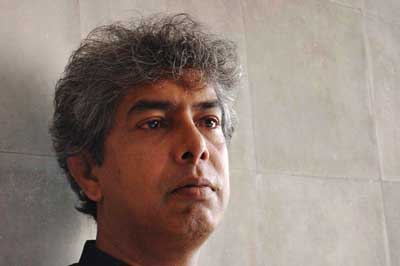
Dhali Al Mamoon
Dhali Al-Mamoon is a painter and a lecturer at Chittagong University. He was born in 1958, in Chandpur, Bangladesh. He holds a Master’s Degree in Fine Arts, University of Chittagong. He received the National Award 2000, Shilpakala Academy, Dhaka, for the best art work of the year and the Grand Prize in the 12th Asian Art Biennale, Dhaka, 2006


